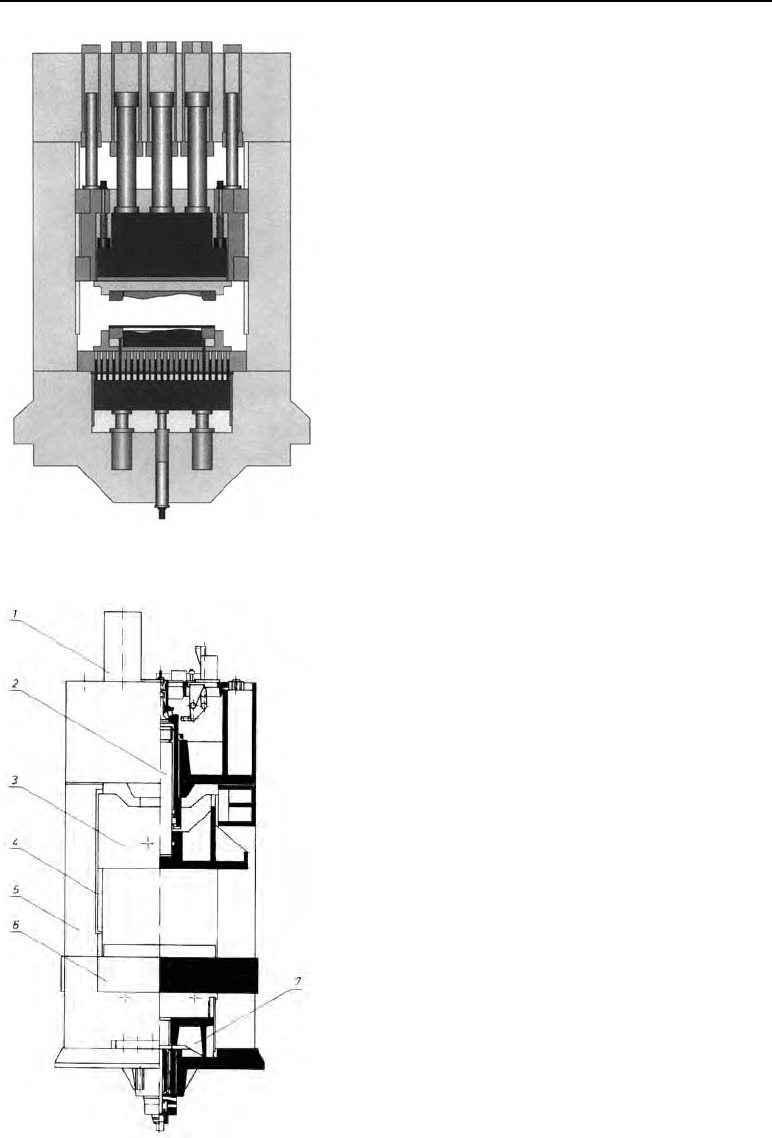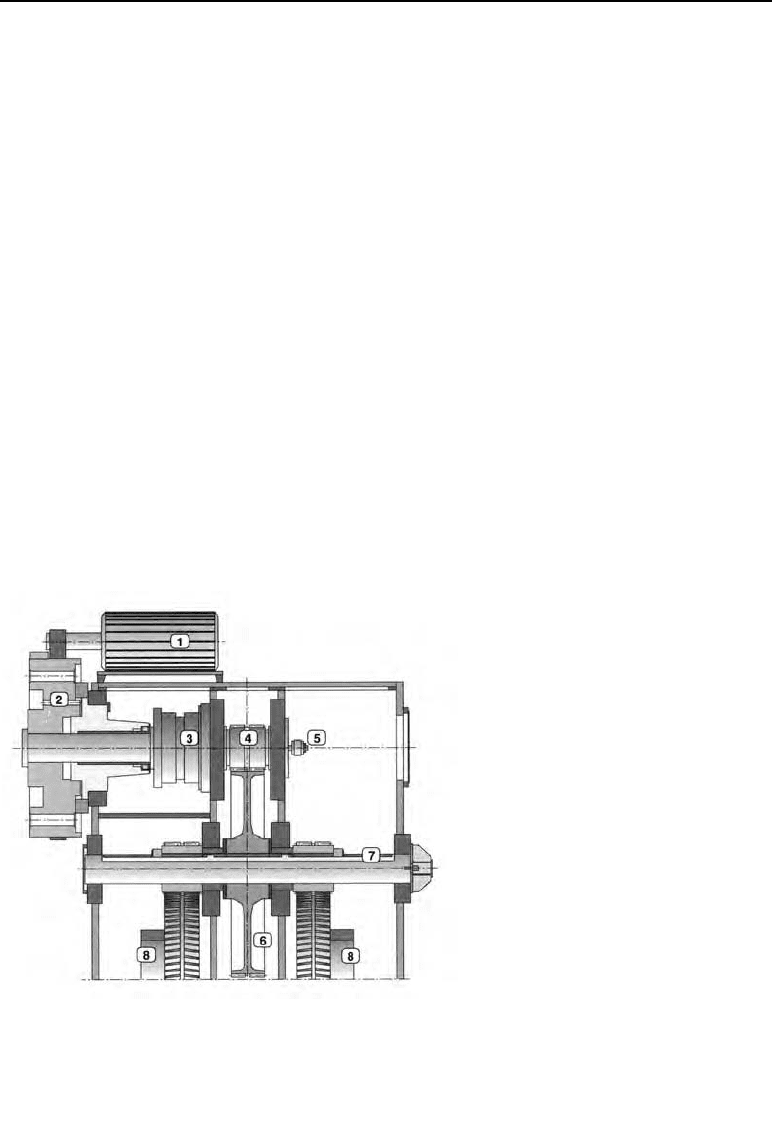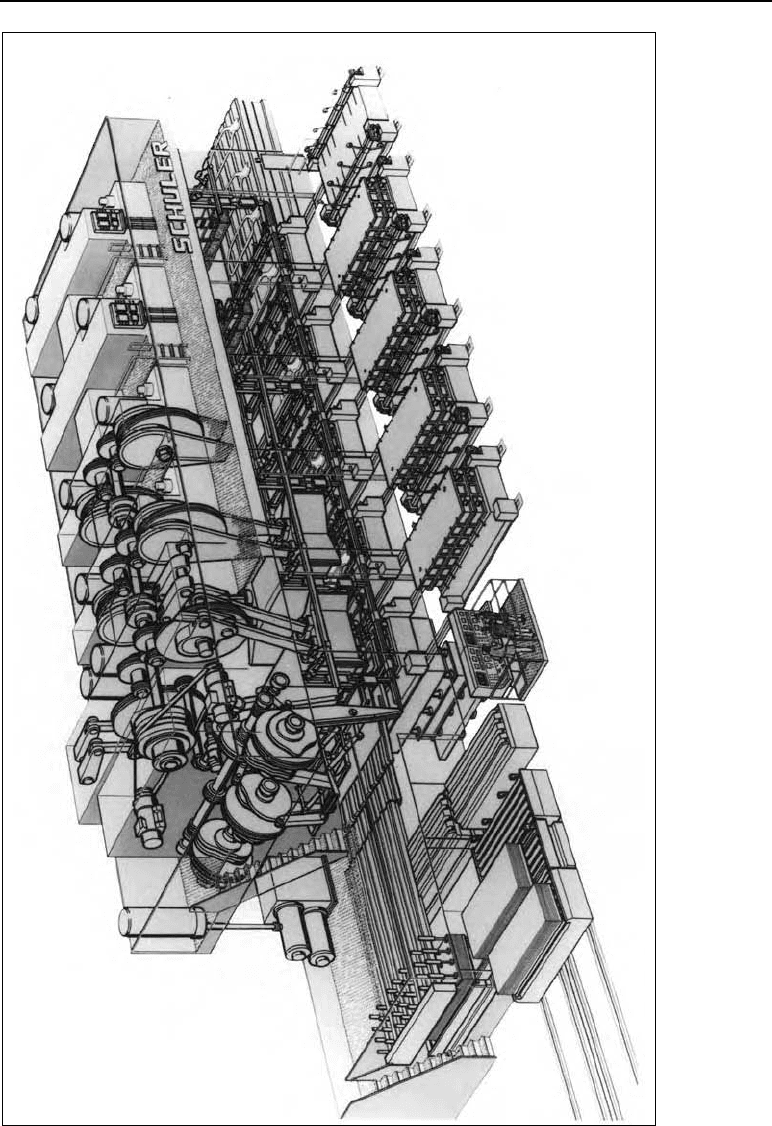Tsch?tsch H., Koth A. Metal Forming Practise: Processes - Machines - Tools
Подождите немного. Документ загружается.


26.4 Practical application of hydraulic presses 321
26.3 Advantages of hydraulic presses
The advantages of hydraulic presses are:
a) constant power all through the stroke,
b) force can be finely regulated (so no extra load-limiting safety device required),
c) work capacity unlimited until W
max
= F
max
· s
max
.
One disadvantage is the lower operating speed compared with crank presses, which results in
lower output (parts per time unit).
26.4 Practical application of hydraulic presses
26.4.1 Drawing presses
Generally wherever constant power along a
long stroke depth is required:
forward extrusion of long parts,
ironing,
embossing and coining (here, there is enough
time for material to flow),
deep drawing.
Triple-action drawing press
For deep drawing, triple-action presses are
sometimes used (Figure 26.4). The press
shown here consists of two main elements: the
p
ress frame and the blank holder, as well as an
ejector or a die cushion in the bottom platen
(Figure 26.4a).
The inner ram drawing depth is determined by
the relative stroke setting which can also be
used to link the blank holder and the inner ram.
Once the blank holder and the inner ram move
down, the blank holder builds up the required
pressure. Then the actual drawing process is
carried out by the inner ram. Finally, the drawn
p
art is knocked out by the ejector (see also
Chapter 14.9).
Figure 26.4 Cross-section of a triple-
action hydraulic drawing press
(Illustration from Schuler, SMG
GmbH & Co. KG, Waghäusel,
Germany)
If the layout includes a die cushion in the bottom platen and the blank holder and inner ram are
linked by the relative stroke setting, conventional drawing tooling can also be used on the
press.

322 26 Hydraulic presses
Figure 26.4a
Layout of blank holder, drawing ram and ejector on
the drawing press shown in Figure 26.4a (Illustra-
tion: Schuler, SMG GmbH & Co. KG, Waghäusel,
Germany)
26.4.2 Deep drawing percussion presses
Deep drawing percussion presses are also
double- or triple-action drawing presses which
can work both as normal drawing presses and
also as drop hammers. In the double-action
hydraulic deep drawing percussion press
shown in Figure 26.5, a drawing press is com-
bined with a hammer. The die cushion to
operate the blank holder is built into the lower
part of this press, under the platen. It is driven
separately, so the drawing ram and the die
cushion can be controlled completely inde-
pendently of one another.
The die cushion can also act as an ejector.
Figure 26.5
Electric/oil hydraulic deep drawing percussion
press
1 axial piston pump, 2 press piston, 3 ram
4 ram guide, 5 press frame, 6 bottom platen,
7 deep drawing die cushion
(Illustration from LASCO Umformtechnik works,
Coburg, Germany)

26.4 Practical application of hydraulic presses 323
This press is equipped with a program control which can be used to pre-select the operating
principle. For example:
1. deep drawing,
2. heavy bottom finishing with hammer (up to 5 hammer blows from different drop heights).
Highly accurate combined drawn and bottomed parts can be produced by bottoming with a
hammer. Whereas the workpiece often springs back with a pure deep drawing operation, bot-
toming with a hammer can stop the material from moving. The forces which result from the
bottoming can be calculated from the relationship
Force =
work
deformation displacement
.
As the deformation displacement is very small in bottoming, high forces result which form the
workpiece very precisely. This outstanding characteristic makes the press ideal for manufactur-
ing difficult drawn and bottomed parts.
26.4.3 Hydraulic extrusion presses
The hydraulic extrusion press shown in Figure 26.6, with a press force of 3,150 kN, stands out for
its highly bend- and twist-resistant double-sided press frame. The eight-part ram guide system
with no play is set out like a cross. This system gives the ram close directional accuracy and at the
same time makes it very sway-resistant. Sway resistance is also increased by the high ratio of the
ram length to the ram width, L/W.
Workpieces can be ejected from the lower or upper die as required thanks to hydraulic ejector
pins in the platen and ram.
The machine comes with a fully programmable PC control system (PC-5000 type). It has menu
navigation and can therefore be operated with little training by any worker familiar with CNC
machines. Instead of the computer control system, another option is to use a CNC-50 type
CNC control system with a disc drive.
Hydraulic extrusion presses are used for manufacturing larger workpieces using a cold forward
extrusion method. This kind of workpiece requires constant force across a long distance. This
is provided with a hydraulic extrusion press, as the available deformation force does not de-
pend upon the deformation distance.
The ram guidance system described above offers optimum guidance, meaning that these pres-
ses can be used to produce very precise extrusions requiring no chip-producing finishing work.

324 26 Hydraulic presses
Figure 26.6 Hydraulic double-sided extrusion press (Photograph: Dunkes GmbH works, Kirchheim
unter Teck, Germany)
26.5 Exercise on Chapter 26
1. Explain the drive layout of a hydraulic press.
2. How is the ram speed raised on the return stroke?
3. Why is high speed on the return stroke desirable?
4. What is the difference between a double-action and a single-action press?
5. What kind of operations are double-action or triple-action presses needed for?

27 Special-purpose presses
Special purpose presses are those which are designed for very precise fields of application or
operations.
These presses can be powered by hydraulic or crank drives. Some examples of special-purpose
presses are:
– deep drawing transfer presses for sheet forming
– transfer presses for bulk forming
– forging presses for impression-die forging
– extrusion presses for hot and cold extrusion
– automatic punching presses for the automatic production of stamped parts.
Of the special-purpose presses described above, three will now be described in more detail.
27.1 Deep drawing transfer presses
Transfer presses are special machines for workpieces requiring several operations. As they are
mainly used to manufacture drawn sheet parts, their basic construction is that of a drawing
press. They have a double-action ram. Whereas only one die set is mounted on a normal draw-
ing press, a transfer press holds several. The number of die sets corresponds to the number of
operations required to produce a drawn part. Figure 27.1 shows a drawn part of this kind, re-
quiring 11 manufacturing operations. Figure 27.2 shows the Weingarten transfer press used for
this workpiece with the die sets ready for use. The press frame is a steel-plate construction. It
consists of the platen, the press columns and the head. These parts are joined using hydrauli-
cally pre-tensioned steel tie rods, forming a stable frame.
Figure 27.1 Sequence of operations for a drawn part

326 27 Special-purpose presses
a)
b)
Figure 27.2 Tool space (Figure a) and tooling set (Figure b) of a deep drawing transfer press with
4500 kN press force (Photograph: Weingarten works, Weingarten, Germany)

27.1 Deep drawing transfer presses 327
Figure 27.3
Set-up of a four-column bulk transfer press system
with three rams, six forming stages and a press force of 38,000 kN.
(Illustration: Müller-Weingarten works, Weingarten, Germany)

328 27 Special-purpose presses
The principle of construction for a bulk transfer drawing press with a gripper rail transfer (Fig-
ure 27.3) is based on the press, transfer and stock feed working together as a unit. The design
mainly depends upon the range of parts, the tooling dimensions these require and the deforma-
tion process.
Between four and six forming stages are required to produce car body parts, according to diffi-
culty. As well as deep drawing operations, bending, flanging, stamping and embossing opera-
tions can also be carried out in a sequence of this kind. The number of rams is determined by
the number of forming stages needed. The number of rams also determines the number of press
columns which give the presses their name:
1 ram = 2 columns; 2 rams = 3 columns; 3 rams = 4 columns.
The press system shown in Figure 27.3 is therefore a four-column press with three rams and
six deformation stages divided thus: 1 + 3 + 2. It is equipped with a hydraulic or pneumatic
die cushion and has a maximum press force of 38,000 kN. The central drive moves not only
the rams, together, but also the transfer system.
As the drive principle (Figure 27.4) shows, the moment is transmitted from the RPM-regulated
motor (1) to the flywheel (2). As soon as the hydraulic clutch (3) is closed, the ram movement
is initiated by means of the pinion (4) and the transmission gear (8), moving the pinion shaft
(7). The eccentric herringbone gears (8) then move the crank arms of the ram kinematics, thus
causing the ram to move.
Figure 27.4
The principle of the drive on the
bulk transfer press shown in Figure
26.3.
(Illustration: Müller-Weingarten
works, Weingarten, Germany)
To ensure that the path of the movement is optimal, as a rule these presses are fitted with a
drive with several joints (Figure 27.5) known as HiPro kinematics. The kinematics is con-
structed in such a way that in conjunction with a drawing device, even difficult parts can be
produced with no difficulty.

27.1 Deep drawing transfer presses 329
Figure 27.5 Ram kinematics with a multi-joint drive (HiPro kinematics) (Illustration: Müller-Weingarten
works, Weingarten, Germany)
Parts are transported from one tooling station to the next by means of a gripper rail transfer
system. The transfer system functions are divided into three axes.
Axis 1: grip part; axis 2: lift part; axis 3: move part forwards.
In this system, the transfer system drive is connected directly to the press drive via a transmis-
sion gear. This ensures that the movements of the press and transfer system are precisely syn-
chronised. The movements of the three transfer axes are initiated by cams. The profiles of the
cams are traced by cam followers and transferred to a lever system.
Figure 27.6 shows a large-capacity transfer press from the Schuler company. The drive
principle is comparable to the Müller-Weingarten transfer press described above. In both
presses, the blanks are fed in (in Figure 27.6 front left) by stack systems (known as de-
stackers) which automatically conduct the blanks into the press: from here the gripper
transport system conveys the blanks into the working area. At the end of forming the fin-
ished parts are brought out of the press in the unloading station.
To ensure that tool changes are efficient, bulk transfer presses are fitted with sliding tables
which move automatically (Figure 27.6 shows four sliding tables to the right of the press); the
tooling which is about to be mounted is placed here. These sliding tables, which are powered
by frequency-regulated motors, move in and out at right angles to the direction of production.
When the tooling is changed, the die sets are driven out of the preparation area into the press
operation area. Here they are automatically located and clamped in place. In the past when
assembly was carried out manually, it took one or two weeks to change to a new workpiece.
Today, in the age of automation, only two or three hours are needed. The whole unit is oper-
ated by only three people and monitored on computer screens.

330 27 Special-purpose presses
Figure 27.6
The drive of a large-capacity transfer press. Crank mechanism to drive the press;
control discs to drive the workpiece transpo
rt system.
(Illustration from Schuler works, Göppingen, Germany)
